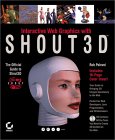by Timothy Martin, CEO and Editor-in-Chief read it |
| Send your url for review in the VirtuPortal! |
| Give us your email for regular news & updates about us |
 |
|
| Book review: Interactive Web Graphics with Shout3D. by N. Polys. Maybe you've seen it on a Macy's runway, or on NBC's website of the Olympic Games, it's hard to miss… it's Shout3D: a realtime 3D, plugin-less renderer with a powerful API for application integration. |
 |
|
The latest generation of Web3D Java applets released from Shout Interactive brings powerful 3D capabilities to web browsers without a plug-in. Using a lightweight, Java-based renderer, Version 2.0 provides increased stability to programmatically manipulate the scene graph, interoperate with networked Java Apps, use advanced Appearances, and use OpenGL Hardware accelleration. Focusing its sites on developers and designers looking to leverage the new Shout3D 2.0, quality computer book publisher Sybex Inc. put out the Official Guide to Shout3D: Interactive Web Graphics with Shout3D. WebReference.com technical author Rob Polevoi puts together a clear and pragmatic manual for publishing 3D content on the web using Shout3D. The book starts with description of the installation package and a break-down of display parameters for the 3D applet. Setting these parameters is easy when converting VRML content using the Shout3D Wizard, and an Exporter for 3D Studio Max/Character and Spazz3D means outputting is easy from a variety of authoring packages.
Especially useful for 3D Studio Max users are a few chapters dedicated to export issues from Max, such as 3D object hierarchies, advanced materials and appearance, and keyframed animation. Although the text bounces around between code-view and Max-view, Polevoi explains crucial techniques such as building MultiMesh, MultiAppearance, Environmental & Light Maps, and Panorama nodes. We also get a nice look at the new support for Bezier, TCB spline-based, and procedural animations which is very cool. The lessons laid clear here will insure that authors construct their scenes properly to get the interactivity and functionality they desire.
After running through 3D content tips, focus turns towards the workings of Shout3D with a Java Primer and an introduction to the elements of a Shout3D project. I like the inclusion of the Java primer: easily digested descriptions of Java fundamentals such as classes and extensions, fields and methods, data types, and interfaces and abstract classes get one up-to-speed quickly. Polevoi keeps the pace, drilling into the guts of this powerful, extensible system and builds a number of user interface panels which approximate the standard VRML navigation modes. Every example shows a unique way to interact with the contents of the scene, detailing how to connect mouse input to the scene by setting DeviceObservers, RenderObservers, and driving object or camera fields by user input or through procedural animations. Authoring with classes, applets, and panels is just the beginning for the Shout3D system as developers can build custom nodes to instantiate into their scenes and connect with other applications. The book's final act explores this capability by building a custom Viewpoint node and a multi-viewpoint application with a Graphical User Interface (GUI) using the AWT package. The final chapter brings it all together with the entertainment app par-excellance- a 3D game. This relatively simple example, Scan the Skies, again underscores the powers of Shout3D by demonstrating scene-graph picking (intersecting projectiles), post-rendering effects like the dashboard Heads-Up-Display and active panel resizing. The book comes with a CD, but some chapter examples were omitted in the first printing, so its wise to go to the Shout3D.com website and download the Shout3D 2.0 package plus all the examples and demos from the book. In addition to the Shout3D classes, demos, Wizard, and 3D Studio Max exporter, the installation package contains great resource documentation such as the user-guide, the specification and JavaDocs so developers have first-hand access to the details of the API, as well as dedicated tutorials to Workflow and 3D Studio Max. A timely and useful book which we highly recommend for web developers, Java application programmers, 3D developers, and 3D designers looking to create and integrate interactive 3D worlds on the internet. BUY The Book here! Shout3D's licensing model has changed: |
|
| Current features * Core Web3D Book * Spazz3D: Authoring-tool * Game Programming in VRML Previous Features
|

VirtuWorlds, VirtuWorld, VirtuPortal, and 3DEZine are Trademarks of VIRTUWORLDS LLC.
No unauthorized uses are permitted.
© VirtuWorlds 1999, 2000